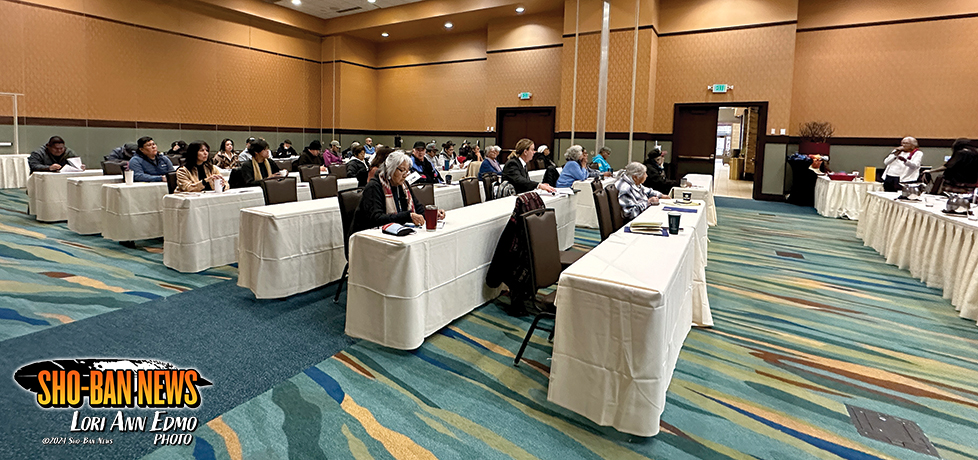Land & water discussed at Elders for Justice presentation

Attendees at the Elders for Justice presentation.
By LORI ANN EDMO
Sho-Ban News
FORT HALL — The Elders for Justice conducted a session for Shoshone-Bannock landowners November 18 at the Shoshone-Bannock Casino Hotel Events Center where Louise E. Dixey gave information related to range issues and Dave Bollinger talked about the Fort Hall Irrigation Project.
In addition, retired Bureau of Indian Affairs employee Cecil Breland also answered questions and Michelle Pak from USDA Natural Resources Conservation Service explained the Conservation Reserve Program. CRP is where landowners agree to remove environmentally sensitive land from agricultural production and plant species that improve environmental health and quality. In exchange they receive annual rental payments and cost-sharing payments.
Dixey explained about the Fort Hall Reservation when it was created, the different homelands (teviwa) from which our tribal people were removed, the land cessions and place names. Ross District is referred to as Under the Mountain – Kaiva Tuhutte in Bannock or Doya Tunkde in Shoshone. Lincoln Creek District is the old schoolhouse – Peai tevofui Ghani in Shoshone or mua tevopunni in Bannock. Bannock Creek is referred to as Muddy Creek – Pasagway huude in Bannock or Saikwi hunnu in Shoshone. Gibson District is “Sagebrush Hill” – Sagwavi Katede in Bannock or Pohogoy in Shoshone. Fort Hall District is referred to as Superintendent’s House – Upetsi Novi in Bannock or Appetsi a ghani in Shoshone.
Currently the rez is 546,000 acres with 97% in trust owned by the Tribes and individual allottees. There are 6,187 enrolled tribal members.
Dixey said she was on her own time to do the presentation and not speaking on behalf of the Tribes. She and her late husband Clyde Duke Dixey Sr. naape were ranchers for 45 years and had access to the range information. She also was previously employed at the Bureau of Indian Affairs and worked as a paralegal in the tribal attorney’s office.
The Fort Hall Business Council adopted resolution 2020-0704 that spells out the terms and conditions for the award and operation of reservation range units. Under Article VIII Section II of the Tribes Constitution, it reads Tribal land, which is not assigned, including timber reserves, shall be managed by the Business Council for the benefit of the entire tribe and any cash income derived from such land accrue to the benefit of the Tribes as a whole. The Tribes contracted the management of the Range program in 2018 pursuant to P.L. 93-638. The Land Use Range program manages the range lands for the Tribes pursuant to 25 CFR 166. There are 14 separate range units the Range program manages that cover 320,292 acres of land spread across long distance and over approximately 1,544 fractionated undivided allotted and Tribal tracts whose landowners will be notified of the Tribes intent to grant grazing permits on their behalf, if they are unable to negotiate and agree upon a permit during a three-month negotiation period.
She showed a map of the range units and talked about Unit 3 where there are 126,089.71 total acres of which 119,591.71 are usable acres. A total of 56,602.28 is tribal land and 69,487.43 is allotted land. The stock rate is 2,197 head. The allocation rates are $8.50 AUM (animal unit months) for tribal members and the non-tribal rate is $29.50 AUM. Data from 2020 through December 2025 – Unit 3 has 135,000 total acres with 1,000 unusable. A total of 60,000 acres is tribal land or 44% and 74,000 is allotted land or 56%. The stocking rate is 3,986. Tribal permittees allocation rate is $8.50 per AUM. Range improvement fee is $1 AUM payable by both the permittee and the landowners. However, the Tribal rate shall be reduced to ensure the allotted tracts receive the $28.50 per AUM.
Fort Hall Irrigation Project Manager Dave Bollinger explained it provides water for agricultural uses on the Fort Hall Indian Reservation and ceded lands. The project started in 1894 and went through multiple phases of construction until completed in 1954. The Project water comes from multiple sources including the Blackfoot and Snake Rivers. The units that make up the Project are the Fort Hall Unit (1907), the Michaud Unit (1954) along with three minor units Bannock Creek, Lincoln Creek and Ross Fork Creek (1948).
The BIA owns the facilities. Operations and maintenance are funded by revenues generated from landowners and lessees. O and M is performed under federal guidelines codified in Title 25 CFR, Part 171. There are 2,172 irrigation structures and two pumping plants: the Portnuef Pumping Plant and the Bannock Pumping Plant. Blackfoot Dam and the Equalizer Dam are classified as high hazard potential dams and are assets operated by the Project but are also managed under the BIA Safety of Dams program.
Concerning water conduits there are 105 miles of canals, 87 miles of laterals, 129 miles of sublaterals and 18 miles of drains.
The Portneuf Pumping Plant is located four miles northwest of Chubbuck on the Portneuf River. It consists of three 110 cubic feet per second (cfs) pumps lifting water about 90 feet.
The Bannock Pumping Plant is 11 miles southwest of Chubbuck. It consists of 25 cfs pumps that left water 81 feet and three 112 cfs pumps that lift water 154 feet.
Blackfoot Dam – It was built from 1908 to 1911, and the U.S. Indian Irrigation Service modified it in 1923-24. The U.S. Army Corps of Engineers again modified it in 1985. The reservoir capacity is 337,000-acre feet. The structural dam height is 54 feet. The reservoir drainage area is 590 square miles. The spillway capacity is 23,000 cfs. Outlet works capacity is 2,250 cfs.
The Equalizer Dam was built in 1937 by the U.S. Indian Irrigation Service. It is two miles southeast of Blackfoot on the Blackfoot River. The reservoir capacity is 2,652-acre feet and the structural dam height is 23 feet. The reservoir drainage area is 1,250 miles. The spillway capacity is 833 cfs a. Outlet works capacity is 950 cfs at the river and 1,100 cfs at the Fort Hall Main Canal Outlet Works.
The Project was authorized under the Act of August 5, 1894, initial. Enabling Act on March 1, 1907, and National Industrial Recovery Act of 1933. Project funding summary: O & M rates: $27-$72.50 per acre (2015) $31-$83 per acre (2016). Estimated annual revenue processed through NIIMS: $3,026,493 (2015). Irrigation and crop information: Assessed acres: 72,058 (2015). Primary crops: Wheat, potatoes, alfalfa, corn, sugar beets and grassland/pasture. Estimated crop value ranges from $82.7 to $101.1 million (2023).
Bollinger read information from a September 24, 1936 solicitors’ opinion that said the Indian owners of lands on the Fort Hall Indian Reservation do have the right to receive water without payment of assessments for operation and maintenance, regardless of the nature or restrictions on their title or whatever the lands are still held by the original allottee of his heirs.
Ross Fork resident Dan Ariwite advised Bollinger of a non-Indian who has no rights on the reservation blocks off the canal with plywood hoarding the water.
Another resident asked if an Indian Water Users group can be created similar to the non-Indian water user’s group. Bollinger advised yes it can, but the group needs to create bylaws to follow.
Michelle Pak of NRCS said they provide financial and technical assistance with natural resources. NRCS has a small office within the ARM program. She said the CRP rate changes every year, but the contract is for ten years. It’s about the health of the grass and it has to be maintained.
Bannock Creek resident Russell Haskett said he sees cattle on the CRP in Bannock Creek and asked who monitors it? He also asked does the NRCS track whether it is being fenced? He believes it needs to be audited as it is not being fenced. He said the tribal people have a right to know if tribal land is involved as we are all shareholders.
Pak replied when they get reports of violations they do check and attempt to resolve the issues.
Arnold Appenay said when he worked in Land Use the CRP land had to be maintained and it cannot be grazed upon.
There were other questions or concerns about right of ways.
Elders for Justice members said they do plan to put on another workshop so people can ask more questions or express concerns.





